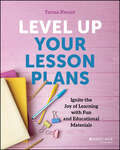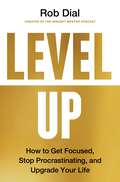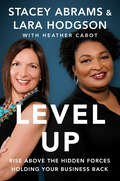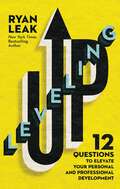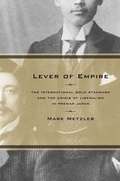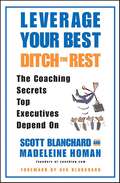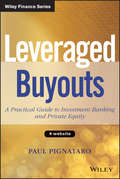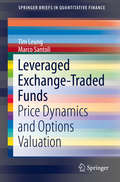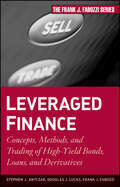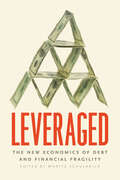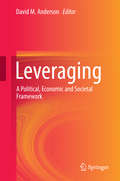- Table View
- List View
Level Up Your Lesson Plans: Ignite the Joy of Learning with Fun and Educational Materials
by Teresa K. KwantLevel Up Your Lesson Plans: Ignite the Joy of Learning with Fun and Educational Materials Tired of spending hours on lesson plans? Discover strategies to streamline your planning process and maximize student engagement. Access exclusive templates, tools, and resources designed to help you create effective lessons that align with learning standards. Save time, reduce stress, and elevate your teaching game. In Level Up Your Lesson Plans: Ignite the Joy of Learning with Fun and Educational Materials, teacher Teresa Kwant delivers an exciting and practical instruction book for teachers interested in adding fun into their lesson plans, without sacrificing educational strategies. The book walks you through how to transform your teaching materials and lessons into interactive, collaborative and enjoyable learning experiences for both the teacher and students. Kwant draws on personal and professional experiences to give actionable steps you can implement immediately. You'll also find: Tips for aligning your lessons with standards to make them both fun and engaging Strategies for building your own instructional plans for daily success with student learning Techniques to develop your own lessons plans efficiently, and with high engagement Perfect for new and veteran classroom teachers looking for student engagement tips, Level Up Your Lesson Plans is a hands-on playbook for planning smarter, so you teach better. This book is the hands-on, creative teaching playbook the education community has been waiting for.
Level Up: How to Get Focused, Stop Procrastinating, and Upgrade Your Life
by Rob Dial“Packed with valuable insights, unique lessons, and practical steps, this book will help you break through your procrastination and take immediate action toward your goals.”—Jay Shetty, New York Times bestselling author of Think Like a Monk and 8 Rules of LoveLevel Up will revolutionize the way you approach your life and your goals. This book from world-renowned high-performance coach and host of The Mindset Mentor podcast, Rob Dial, presents a groundbreaking roadmap to unlock your full potential and transform your life. In it, you will find:A transformative system designed to revolutionize the way you approach your goals, success, and personal motivation.Powerful secrets of highly successful individuals who have mastered the art of focus, defeated their procrastination, and achieved extraordinary results.Cutting-edge research in neuroscience and psychology, unveiling the science behind mental focus and motivation.Tools that empower you to understand and control your mind like never before. This book has cracked the code to peak performance and you will learn how to apply these secrets to your own life. Level Up is not just another self-help book. It is a step-by-step guide that helps you get from where you are now to the life you truly want to be as fast as possible.Whether you're struggling with distractions, overwhelmed by a chaotic schedule, or simply seeking a path to personal excellence, Level Up is the game-changer you've been waiting for.
Level Up: Rise Above the Hidden Forces Holding Your Business Back
by Heather Cabot Stacey Abrams Lara HodgsonAn inspiring and revelatory guide to starting and scaling a small business, from powerhouse duo Stacey Abrams and Lara Hodgson Like many business owners, renowned politician and activist Stacey Abrams didn&’t start a business because she dreamed of calling herself an entrepreneur. Her part-time post (and its $17,310 annual salary) as a member of the Georgia House of Representatives necessitated striking out on her own as a consultant—her first small business. Then, Stacey and her friend Lara Hodgson launched an infrastructure advisory firm—named Insomnia Consulting because they did their best thinking at 3:00 a.m.—and then another business, and then another. Fifteen years into their entrepreneurial journey together, they have tackled the obstacles that many business owners face: how to grow sustainably, hire thoughtfully, and keep up with the Goliaths in your industry. Now, for the first time, Stacey and Lara share their inspiring and relatable personal story and lessons learned the hard way to show how every business owner can confront the forces that conspire to keep small businesses small. Lauded for her &“resilient, visionary leadership&” (Barack Obama) and celebrated as a &“passionate advocate of democracy&” (Madeleine Albright), Stacey now brings her fierce sense of justice to the challenges that America&’s business owners face. Level Up arms readers with the confidence, know-how, and savvy to overcome the obstacles that hold their businesses back.
Leveling Up: 12 Questions to Elevate Your Personal and Professional Development
by Ryan LeakA Wall Street Journal BestsellerExperience explosive growth and success in your career and personal life by taking ownership of your personal development and understanding you don't need to know all the answers—but you do need to ask the right questions.Whether you're a leader of ten, a hundred, or many more, there's no one more important to lead than yourself. If you're not leading yourself, why would anyone else want to follow you? Ryan Leak speaks to thousands of leaders every year, and he has learned that the most successful people have taken ownership of their own development—and in order to realize your potential, you need to fully understand yourself.Being a great leader is not about having all the answers but asking the right questions—and that starts with careful introspection and inviting others to tell you what they see in you. Leveling Up helps you focus on the person you're becoming and think about the goals you want to accomplish. Some of the twelve strategic questions in this book include:What is it like to be around me? (The Self-Awareness Question)What credit can I give away? (The Team Player Question)Who knows who I really am? (The Transparency Question)What's my definition of success? (The Vision Question)Do I have to do it all? (The Rest Question)Am I enjoying it? (The Fun Question) Leadership theory and business practices are important to study, but nothing is better than discovering the answers that will reveal who you are at your core, where you want to go in your career and life in general, and how you can influence and impact those around you.
Leveling the Learning Curve: Creating a More Inclusive and Connected University
by William B. Eimicke Soulaymane Kachani Adam StepanWill the COVID-19 pandemic be remembered as a turning point in how universities deliver teaching and learning? How might the widespread use of digital tools change higher education?This groundbreaking book explores the role of digital education at this crucial crossroads. Built on interviews with more than fifty leading practitioners from major universities and ed-tech firms, Leveling the Learning Curve is an indispensable guide to the inner workings of digital education. Written for university managers and leaders, it explores how new tools can allow universities to reach new audiences and address long-standing imbalances. The authors examine challenges to implementing digital education programs and provide insight into how universities have managed to balance the needs of faculty and on- and off-campus students. The book traces the history of digital education initiatives from Khan Academy, TED Talks, and MOOCs through the pandemic, examining both successes and failures. It offers compelling examples of what a “connected university” looks like in practice, sharing ways digital tools can bring in wider audiences, expand interdisciplinary teaching and learning, connect students to real-life issues, help meet equity goals, and open new revenue streams.Designed as both a manual and an in-depth study, Leveling the Learning Curve is required reading for educational leaders looking to navigate the complex waters of postpandemic digital education.
Levelized Cost of Energy in Sustainable Energy Communities: A Systematic Approach for Multi-Vector Energy Systems (SpringerBriefs in Applied Sciences and Technology)
by Miguel de Simón-Martín Stefano Bracco Giorgio Piazza Luisa Carlotta Pagnini Alberto González-Martínez Federico DelfinoThe main aim of this book is to provide a state of the art of the Levelized Cost of Energy calculation for energy communities from both a theoretical, defining a systematic analysis approach, and a practical point of view, providing results for three representative real case studies.The book is structured in four clear chapters which cover everything from the fundamentals of power system configuration and the LCOE concept, to the definition of the aggregated system LCOE and its impact on electricity markets and energy policies. It presents case studies, within multiple examples for energy generation and storage, making it a brief but well-rounded review. The book will be useful for researchers and academics in energy economics, power systems and energy policies, for energy policy makers and students.
Levelling Up Left Behind Places: The Scale and Nature of the Economic and Policy Challenge (Regional Studies Policy Impact Books)
by Ron Martin Peter Sunley Andy Pike Peter Tyler Ben GardinerEXECUTIVE SUMMARY AND KEY RECOMMENDATIONS The nature of the problem: • Geographical inequalities in the UK are a longstanding and persistent problem rooted in deepseated and cumulative processes of local and regional divergence with antecedents in the inter-war years and accelerating since the early 1980s. • This spatial divergence has been generated by the inability of some places to adapt to the emergence of the post-industrial service and knowledge-based economy whose geographies are very different from those of past heavy industries. As a consequence, the "left behind" problem has become spatially and systemically entrenched. • Challenging ideas of market-led adjustment, there is little evidence that real cost advantages in Northern areas are correcting and offsetting the geographically differentiated development of skilled labour and human capital and the quality of residential and business environments. • A variety of different types of "left behind place" exist at different scales, and these types combine common problems with distinctive economic trajectories and varied causes. These different types will need policies that are sensitive and adaptive to their specific problems and potentialities. • Contemporary economic development is marked by agglomeration in high-skilled and knowledge-intensive activities. Research-based concentrations of high-skilled activity in the UK have been limited and concentrated heavily in parts of London and cities in the Golden Triangle, especially Oxford and Cambridge. Even in London, the benefits have been unevenly spread between boroughs. • Existing analyses of the predicaments of left behind places present a stark division between rapid growth in "winning" high-skilled cities and relative decline in "losing" areas. This view is problematic because it oversimplifies the experience in the UK and other countries. A false binary distinction is presented to policymakers which offers only the possibility of growth in larger cities and derived spillovers and other compensations elsewhere. • Yet, the post-industrial economy involves strong dispersal of activity and growth to smaller cities, towns and rural areas. However, this process has been highly selective between local areas and needs to be better understood. The institutional and policy response: • Past policies in the UK have lacked recognition of the scale and importance of the left behind problem and committed insufficient resources to its resolution. The objective of achieving a less geographically unequal economy has not been incorporated into mainstream policymaking. When compared with other countries, the UK has taken an overcentralized, "top-down" approach to policy formulation and implementation, often applying "one size fits all" policy measures to different geographical situations. • Political cycles have underpinned a disruptive churn of institutions and policies. In contrast with other Organisation for Economic Co-operation and Development (OECD) countries, particularly in Europe, there has been limited long-term strategy and continuity, and inadequate development of local policymaking capacity and capabilities, especially for research, analysis, monitoring and evaluation. • Past policies have been underfunded, inconsistent, and inadequately tailored and adapted to the needs of different local economies. We estimate that, on average over the period 1961–2020, the UK government invested on average £2.9 billion per annum in direct spatial policy (2020 prices), equivalent to around 0.15% of gross national income (GNI) per annum over the period. European Union Structural and Cohesion Policy support has added around 0.12% GNI (2020 prices) per annum to this over the period from the late 1970s. • These broad estimates suggest that discretionary expenditure in the UK on urban and regional policy when both domestic and European Union spatial policy was in operation was equivalent to 0.27% per annum of UK GNI (2020
Levendary Cafe: The China Challenge
by Arar Han Christopher A. BartlettJust weeks into her new job, Mia Foster, a first time CEO with no international management experience, is faced with a major challenge at Levendary Caf , a $10 billion US-based fast food chain. Strategically, many of her corporate staff have become concerned that the company's major expansion into China is moving too far from Levendary's well-defined concepts of store design and menu. Organizationally, Foster has been frustrated by the apparent unwillingness of Louis Chen, president of Levendary China, to conform to the company's planning and reporting processes. Meanwhile, financial evidence shows that Chen's efforts have produced strong results and suggests that he knows China far better than U.S headquarters does. The entrepreneurial Chen has resisted attempts by Foster and others to discuss corporate plans for China. As Foster flies to China to meet with Chen she faces a decision that will determine the future of Levendary China and perhaps the entire globalization effort: can she manage Chen at all, and if so, how?
Levendary Cafe: The China Challenge
by Arar Han Christopher A. BartlettJust weeks into her new job, Mia Foster, a first time CEO with no international management experience, is faced with a major challenge at Levendary Caf , a $10 billion US-based fast food chain. Strategically, many of her corporate staff have become concerned that the company's major expansion into China is moving too far from Levendary's well-defined concepts of store design and menu. Organizationally, Foster has been frustrated by the apparent unwillingness of Louis Chen, president of Levendary China, to conform to the company's planning and reporting processes. Meanwhile, financial evidence shows that Chen's efforts have produced strong results and suggests that he knows China far better than U.S headquarters does. The entrepreneurial Chen has resisted attempts by Foster and others to discuss corporate plans for China. As Foster flies to China to meet with Chen she faces a decision that will determine the future of Levendary China and perhaps the entire globalization effort: can she manage Chen at all, and if so, how?
Lever of Empire: The International Gold Standard and the Crisis of Liberalism in Prewar Japan
by Mark MetzlerThis book is the first full account of prewar international money power in Japan, and a dramatically different reading of international monetary history from that given in hitherto European-centered accounts.
Leverage
by Karl Denninger Charles Hugh SmithHow the wealthy and powerful abuse finance to skim immense profits Debasement of the dollar as a result of ill-use of leverage is destroying the global economy, and in Leverage, well known market commentator Karl Denninger follows the path of money throughout history to prove that currencies are debased when moneyed and powerful interests pull the levers of government and policy to enrich themselves at the expense of the masses. The result is ugly: the value of everything--including gold--falls, and even personal safety is at risk in a world where there is limited money even for essentials like food and fuel. History is littered with the collapse of monetary and economic systems from Rome to Germany to Zimbabwe. Presents an inside look at how moneyed and powerful interests debase the dollar through the willful and intentional failure to honestly represent short and long-term mathematical truths that underlie all economic systems Shows how, if imbalances are not corrected, financial crises will reoccur again and again Authored by Karl Denninger, who has been running the popular website The Market Ticker since 2007
Leverage Change: 8 Ways to Achieve Faster, Easier, Better Results
by Robert W. JacobsFrustrated that change efforts you're leading take too long, are too difficult, or are too often ineffective? Discover eight powerful ways to make any change work faster, easier, and better—whether done by C-suite leaders or frontline workers.Organizations suffer from change fatigue. People are impatient and exhausted. They feel like too many initiatives are imposed from above or outside. They don't have time for more change and often don't even see the point in it. Wouldn't it be great if there were a systematic way to achieve your desired results in less time with fewer problems and more success? There is. It's called Leverage Change. These problems and more are resolved by what change expert Robert "Jake" Jacobs calls Levers: smart, strategic actions that create huge leverage and impact. Whether you have an existing change effort that could be turbocharged or you're launching one that's new, the Levers can help. Apply a Lever—even without a formal program—and your organization will experience positive changes. These powerful Levers, which can be used alone or in any combination that works for you, are straightforward and easy to apply:• Pay Attention to Continuity • Think and Act As If the Future Were Now! • Design It Yourself • Create a Common Database • Start with Impact, Follow the Energy • Develop a Future People Want to Call Their Own • Find Opportunities for People to Make a Meaningful Difference • Make Change-Work Part of Daily-WorkDrawing on thirty-five years of experience, Jacobs includes dozens of stories of the Levers in action with all kinds of organizations, teams, and individuals. He also provides specific directions on how you can apply them to your change work. Use the Levers, and improve your change work more than you ever imagined possible.
Leverage Ratios - The Balancing Act: Financial Leverage for Entreprenuers
by Karen Berman Joe KnightIn a small entrepreneurial company, debt can be a big part of what owners think (and worry) about. This chapter focuses on financial leverage (the extent to which a company's asset base is financed by debt) and two ratios: debt-to-equity, and interest coverage. This chapter is excerpted from "Financial Intelligence for Entrepreneurs: What You Really Need to Know About the Numbers."
Leverage Ratios: The Balancing Act
by John Case Karen Berman Joe KnightLeverage ratios let you peer into how-and how extensively-a company uses debt. This chapter discusses debt-to-equity and interest coverage, two leverage ratios that are important for managers to understand.
Leverage Value Over Cost: Developing Customer and Employee Ownership
by James L. Heskett Joe Wheeler W. Earl Sasser Jr.Organizations that foster customer and employee ownership gain an edge on the competition by designing their operating strategies and systems to leverage value over cost. They carefully align all the elements of the strategic value vision to create a unified, self-reinforcing enterprise focused on ownership-and in the process they achieve enviable margins. They pay particular attention to what the authors call "deep indicators," or key value levers that most influence future performance.
Leverage Your Advantages: Generation Y--Shaping Your Personal Career Strategy
by Tamara EricksonAs a member of Generation Y, you have three big advantages: a tightening labor market, the ability to take some risks, and a distinct point of view. Each of these gives you a lot of power in the workplace - the key is learning to leverage them properly. If you can do that, then your strengths will allow you to find a career you love.
Leverage Your Best, Ditch the Rest: The Coaching Secrets Top Executives Depend On
by Madeleine Homan Scott BlanchardLeverage Your Best, Ditch the Rest eliminates the stupid stuff that distracts you and gets in your way. It shows you how to take full advantage of -- Leverage! -- your strengths and most positive qualities, while at the same time discarding or getting around -- Ditch! -- whatever gets in your way.Scott Blanchard and Madeleine Homan, co-founders of Coaching.com, share their groundbreaking program, honed by fourteen years of high-level executive coaching and consulting. They offer new perspectives on how to spend your precious and limited resources, time, emotions, passions, and energy to generate the best results.The three-part process begins with a twenty-five-question self-assessment, then moves on to the Three Perspectives -- major life queries that focus on how you are perceived, your own self-image, and self-imposed limitations. The final step, the Seven Leverage Points, offers fresh insight into the choices you make and how you conduct yourself in business and in life. You will find immediately applicable tools to appraise and manage your work environment and personal gifts. You will be guided to make tiny but crucial shifts in getting needs met and drawing boundaries.
Leverage of the Weak: Labor and Environmental Movements in Taiwan and South Korea (Social Movements, Protest and Contention #42)
by Hwa-Jen LiuComparing Taiwan and South Korea strategically, Hwa-Jen Liu seeks an answer to a deceptively simple question: Why do social movements appear at different times in a nation&’s development?Despite their apparent resemblance—a colonial heritage, authoritarian rule, rapid industrialization, and structural similarities—Taiwan and South Korea were opposites in their experiences with two key social movements. South Korea followed a conventional capitalist route: labor movements challenged the system long before environmental movements did. In Taiwan, pro-environment struggles gained strength before labor activism. Liu argues that part of the explanation lies in an analysis of how movements advance their causes by utilizing different types of power. Whereas labor movements have the power of economic leverage, environmental movements depend on the power of ideology. Therefore, examining material factors versus ideational factors is crucial to understanding the successes (or failures) of social movements.Leverage of the Weak is a significant contribution to the literature on social movements, to the study of East Asian political economies, and to the progress of the comparative-historical method. It enhances knowledge of movement emergence, investigates the possibilities and obstacles involved in forging labor–environment alliances, and offers the first systematic, multilayered comparisons across movements and nations in East Asia.
Leveraged Betas and the Cost of Equity
by Paul AsquithThe objective is to delineate on methodology for measuring the risk associated with financial leverage and estimating its impact on the cost of equity capital.
Leveraged Buyouts
by Paul PignataroA comprehensive look at the world of leveraged buyoutsThe private equity industry has grown dramatically over the past twenty years. Such investing requires a strong technical know-how in order to turn private investments into successful enterprises. That is why Paul Pignataro has created Leveraged Buyouts + Website: A Practical Guide to Investment Banking and Private Equity.Engaging and informative, this book skillfully shows how to identify a private company, takes you through the analysis behind bringing such an investment to profitability--and further create high returns for the private equity funds. It includes an informative leveraged buyout overview, touching on everything from LBO modeling, accounting, and value creation theory to leveraged buyout concepts and mechanics.Provides an in-depth analysis of how to identify a private company, bring such an investment to profitability, and create high returns for the private equity fundsIncludes an informative LBO model and case study as well as private company valuationWritten by Paul Pignataro, founder and CEO of the New York School of FinanceIf you're looking for the best way to hone your skills in this field, look no further than this book.
Leveraged Exchange-Traded Funds
by Tim Leung Marco SantoliThis book provides an analysis,under both discrete-time and continuous-time frameworks, on the price dynamicsof leveraged exchange-traded funds (LETFs), with emphasis on the roles ofleverage ratio, realized volatility, investment horizon, and tracking errors. This study provides new insights on the risks associated with LETFs. It alsoleads to the discussion of new risk management concepts, such as admissibleleverage ratios and admissible risk horizon, as well as the mathematical andempirical analyses of several trading strategies, including static portfolios,pairs trading, and stop-loss strategies involving ETFs and LETFs. The finalpart of the book addresses the pricing of options written on LETFs. Sincedifferent LETFs are designed to track the same reference index, these funds andtheir associated options share very similar sources of randomness. The authorsprovide a no-arbitrage pricing approach that consistently value options onLETFs with different leverage ratios with stochastic volatility and jumps inthe reference index. Their results are useful for market making of theseoptions, and for identifying price discrepancies across the LETF optionsmarkets. As the market of leveraged exchange-traded products become a sizeableconnected part of the financial market, it is crucial to better understand itsfeedback effect and broader market impact. This is important not only forindividual and institutional investors, but also for regulators.
Leveraged Finance
by Frank J. Fabozzi Stephen J. Antczak Douglas J. LucasA timely guide to today's high-yield corporate debt markets Leveraged Finance is a comprehensive guide to the instruments and markets that finance much of corporate America. Presented in five sections, this experienced author team covers topics ranging from the basics of bonds and loans to more advanced topics such as valuing CDs, default correlations among CLOs, and hedging strategies across corporate capital structures. Additional topics covered include basic corporate credit, relative value analysis, and various trading strategies used by investors, such as hedging credit risk with the equity derivatives of a different company. Stephen Antczak, Douglas Lucas, and Frank Fabozzi present readers with real-market examples of how investors can identify investment opportunities and how to express their views on the market or specific companies through trading strategies, and examine various underlying assets including loans, corporate bonds, and much more. They also offer readers an overview of synthetic and structured products such as CDS, LCDS, CDX, LCDX, and CLOs. Leveraged Finance has the information you need to succeed in this evolving financial arena.
Leveraged: The New Economics of Debt and Financial Fragility
by Moritz SchularickAn authoritative guide to the new economics of our crisis-filled century. Published in collaboration with the Institute for New Economic Thinking. The 2008 financial crisis was a seismic event that laid bare how financial institutions’ instabilities can have devastating effects on societies and economies. COVID-19 brought similar financial devastation at the beginning of 2020 and once more massive interventions by central banks were needed to heed off the collapse of the financial system. All of which begs the question: why is our financial system so fragile and vulnerable that it needs government support so often? For a generation of economists who have risen to prominence since 2008, these events have defined not only how they view financial instability, but financial markets more broadly. Leveraged brings together these voices to take stock of what we have learned about the costs and causes of financial fragility and to offer a new canonical framework for understanding it. Their message: the origins of financial instability in modern economies run deeper than the technical debates around banking regulation, countercyclical capital buffers, or living wills for financial institutions. Leveraged offers a fundamentally new picture of how financial institutions and societies coexist, for better or worse. The essays here mark a new starting point for research in financial economics. As we muddle through the effects of a second financial crisis in this young century, Leveraged provides a road map and a research agenda for the future.
Leveraged: The New Economics of Debt and Financial Fragility
by Moritz SchularickAn authoritative guide to the new economics of our crisis-filled century. Published in collaboration with the Institute for New Economic Thinking. The 2008 financial crisis was a seismic event that laid bare how financial institutions’ instabilities can have devastating effects on societies and economies. COVID-19 brought similar financial devastation at the beginning of 2020 and once more massive interventions by central banks were needed to heed off the collapse of the financial system. All of which begs the question: why is our financial system so fragile and vulnerable that it needs government support so often? For a generation of economists who have risen to prominence since 2008, these events have defined not only how they view financial instability, but financial markets more broadly. Leveraged brings together these voices to take stock of what we have learned about the costs and causes of financial fragility and to offer a new canonical framework for understanding it. Their message: the origins of financial instability in modern economies run deeper than the technical debates around banking regulation, countercyclical capital buffers, or living wills for financial institutions. Leveraged offers a fundamentally new picture of how financial institutions and societies coexist, for better or worse. The essays here mark a new starting point for research in financial economics. As we muddle through the effects of a second financial crisis in this young century, Leveraged provides a road map and a research agenda for the future.
Leveraging
by David M. AndersonThis book considers the current domestic and global political and economic landscape and will show that there are three different but related kinds of leverage that together have emerged as the dominant strategy in economics, politics and international relations. The economic crisis of 2008-09 was called by most economists a crisis of "over-leverage. " Yet no one has argued that there has also been a leverage crisis or at least a "leverage challenge," in other aspects of life. The This book argues that there is a "leverage mean" in between the extremes of too little leverage and too much leverage that provides the basis for resolving the various crises and challenges. This book, which grows out of a Brookings Institution paper "The Age of Leverage," will analyze bargaining leverage, resource leverage and economic investment leverage and should draw the attention of students and teachers in political and economic philosophy.
